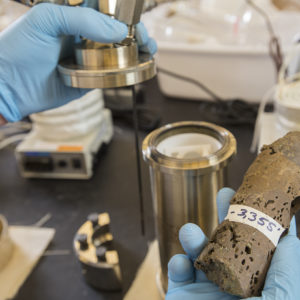When fossil fuels are burned, carbon dioxide (CO2) is emitted. As the gas rises and becomes trapped in the atmosphere, it retains heat as part of a process called the greenhouse effect. The increased temperatures associated with the greenhouse effect can cause melting ice caps, higher sea levels and a loss of natural habitat for plant and animal species.
Environmental scientists trying to mitigate the effects of CO2 have experimented with injecting it deep underground, where it becomes trapped. These trials have mainly taken place in sandstone aquifers, however, the injected CO2 primarily remains present as a bubble that can return to the surface if is there are fracture in the capping formation. A different approach using basalt flows as injection sites — chiefly at the CarbFix site in Iceland and in Washington state — has yielded dramatic results. Metals in basalt have the ability to transform CO2 into a solid inert mineral in a matter of months. While the new method holds promise, the underground injections can be imprecise, difficult to track and measure.

Photo by Joe Angeles/Washington University
Now, new research by scientists at Washington University in St. Louis sheds light on what happens underground when CO2 is injected into basalt, illustrating precisely how effective the volcanic rock could be as an abatement agent for CO2 emissions. The research, led by Daniel Giammar, the Walter E. Browne Professor of Environmental Engineering in the School of Engineering & Applied Science, was conducted in collaboration with researchers at Pacific Northwest National Laboratory and Philip Skemer, associate professor of earth and planetary sciences in Arts & Sciences at Washington University.
“In a field site, you inject the carbon dioxide in, and it’s a very open system,” Giammar said. “You can’t get a good constraint in terms of a capacity estimate. You know you made some carbonate from the CO2, but you don’t really know how much. In the lab, we have well-defined boundaries.”
To obtain a clearer, quantifiable look at carbon trapping rates in basalt, Giammar collected samples of the rock from Washington state, where researchers previously injected a thousand tons of CO2 gas deep underground into a basalt flow. He placed the rocks in small reactors that resemble slow cookers to simulate underground conditions, and then injected CO2 to test the variables involved in the carbonization process.
“We reacted it at similar pressure and temperature conditions to what they had in the field, except we do all of ours in a small sealed vessel,” Giammar said. “So we know how much carbon dioxide went in and we know exactly where all of it went. We can look at the entire rock afterwards and see how much carbonate was formed in that rock. “
The lab kept the basalt in the pressurizers and followed up, using 3-D imaging to analyze their pore spaces at six weeks, 20 weeks and 40 weeks. They were able to watch moment to moment as the CO2 precipitated into mineral, the exact voids within the basalt it filled, and the precise spots in the rock where the carbonization process began.
Once all of the data were collected and analyzed, Giammar and his team predicted 47 kilograms of CO2 can be converted into mineral inside one cubic meter of basalt. This estimate can now be used as a baseline to scale up, quantifying how much CO2 can effectively be converted in entire areas of basalt flow.
“People have done surveys of available basalt flows,” Giammar said. “This data will help us determine which ones could actually be receptive to having CO2 injected into them, and then also help us to determine capacity. It’s big. It’s years and years worth of U.S. CO2 emissions.”
Giammar’s lab is currently sharing its results with colleagues at the University of Michigan, who will assist in developing a computational model to further help researchers to look for a solid fix for CO2 abatement. The Washington University researchers have also been invited to take part in the second phase of the U.S. Department of Energy’s Carbon Storage Assurance Facility Enterprise, or CarbonSAFE, which investigates new technologies for CO2 abatement.
Wei Xiong, Rachel K. Wells, Jake A. Horner, Herbert T. Schaef, Philip A. Skemer and Daniel E. Giammar. “CO2 Mineral Sequestration in Naturally Porous Basalt.” Environmental Science & Technology Letters, February 27, 2018. DOI: 10.1021/acs.eslett.8b00047
This work was funded by the U.S. Department of Energy (DEFE0023382).
